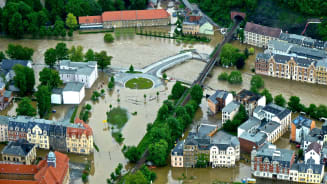Parametric Can Help Mitigate Extreme Heat Risks for Contractors in EMEA

Construction projects in EMEA are often impacted by extreme heat, leading to project delays and increased costs. Many heat exposures are excluded by traditional markets, however, parametric is a flexible solution that can help mitigate these risks.
Key Takeaways
-
As climate change continues to impact EMEA temperatures, construction project delays and increased costs will remain issues for contractors and building owners.
-
During extreme heatwaves, projects involving physical labor take 36 percent longer on average to complete.
-
Parametric insurance is critical to construction risk strategies because of its broad scope, flexibility, and fast and transparent claim settlements.
Extreme heatwaves, fueled by climate change, represent one of the most pressing challenges for the construction industry in Europe, the Middle East and Africa (EMEA).
The most devastating impact is on human health and life, with heat-related deaths surpassing those of any other weather-related danger. This is accompanied by significant indirect health issues, such as respiratory failure, cardiovascular disease and heat stroke.
Like other parts of the world, EMEA has experienced the dire consequences of extreme heat. Aon’s 2023 Weather, Climate and Catastrophe Report highlights two separate major heatwaves in the region in June and July of 2022. These affected hundreds of millions of people, leading to nearly 20,000 heat-related fatalities, as derived from excess mortality rate data.
From a business standpoint, extreme heat creates widespread issues, affecting operations, productivity and employee wellbeing. When temperatures reach unsafe levels for workers, the construction process is delayed, and subsequently, costs rise.
In fact, during extreme heatwaves, construction projects involving physical labor take 36 percent longer on average to execute. This will only grow more severe, as climate change continues to impact temperatures and the average age of the construction workforce continues to rise (from 40.5 in 2015 to 42.5 in 2022).1
In most countries around the world, however, legislation is not specific about what is considered an acceptable range for temperature conditions at work, especially outdoors. Only sometimes does national legislation provide a range of acceptable temperatures for specific circumstances.2
The majority of European countries, too, have no legal maximum working temperatures or heat protection regulations (although most include labor laws requiring workers to be comfortable or safe).
Here is a snapshot of extreme heat labor laws in select EMEA countries:
-
France
- There is no set maximum temperature to work in; employers must ensure safe conditions.
-
Germany
- Employers are required to ensure workers can proceed safely with their activities when temperatures exceed 26 degrees Celsius and provide drinkable water at 30 degrees Celsius.
-
Italy
- There is no set maximum temperature to work in; workers can halt work if conditions are unsafe.
-
Portugal
- Workplace temperatures must be 18-22 degrees Celsius, with humidity at 50-70 percent.
-
Spain
- Work that requires light physical effort should be performed in temperatures between 14 and 25 degrees Celsius.
-
UK
- Like many European governments, the UK has no maximum working temperature provisions.
- In 2022, the General, Municipal, Boilermakers' and Allied Trade Union, which represents workers from a range of sectors, called on the government to introduce “too hot to work” legislation at 27 degrees Celsius for those doing strenuous jobs. It also requires employers to provide sun protection and water.
-
United Arab Emirates
- The UAE prohibits employers from forcing employees to work outdoors between 12:30 and 3 p.m., from June 15 to September 15, which is the hottest time of day.
Parametric insurance allows clients to access alternative capital to enable the transfer of a whole myriad of measurable exposures not met by the traditional insurance market.
Unlike acute perils, the full impact of chronic perils, like extreme heat, are often cumulative and difficult to measure, leaving a potential protection gap. While traditional insurance markets address physical damage, the economic implications faced by clients, including business interruption and loss of employee income, are often more substantial.
How Parametric Solutions Can Help
Parametric insurance is complementary to traditional insurance solutions. It can be used in situations like extreme heat, where a risk must be mitigated and may not be covered via traditional markets.
Unlike traditional insurance, parametric coverage is triggered by predefined parameters, providing quicker and more transparent claim settlements. With its flexibility and broad scope, parametric insurance helps bridge the protection gap, making it an ideal alternative risk transfer solution in catastrophe-prone areas — and in areas where extreme heat is an issue.
“Parametric insurance allows clients to access alternative capital to enable the transfer of a whole myriad of measurable exposures not met by the traditional insurance market.” says Jon Chapman, head of Aon’s construction and infrastructure practice in EMEA. “It creates an avenue for additional capacity for issues that are not covered by traditional insurers and another source for clients to address volatility.”
Parametric takes an “if-then” approach. As more risk managers rethink their risk resilience, this method complements and supplements traditional insurance, paving the way for an innovative and transformative, yet straightforward solution, perfectly suited for catastrophic events.
Here’s how the core mechanics of parametric insurance work:
- The “if:” Parametric insurance stands out due to its coverage trigger and pre-agreed payouts. Underwriting is simplified as coverage is activated by the occurrence of an independent event, as determined by neutral third-party data providers.
- The “then:” With the independent data trigger and pre-agreed amounts, recoveries occur swiftly — often within days or weeks of an event. This quick access to capital is critical for businesses that need immediate financial assistance following an event.
- Solving the protection gap: Parametric insurance offers broad coverage, ensuring that any economic exposure arising from an event can be insured. Previously uninsurable exposures become insurable, with the parametric trigger acting as the missing link to unlock flexible capital.
Parametric Benefits for Construction Stakeholders
| For Contractors | For Building Owners |
|---|---|
|
Reduces contingencies in contract prices |
Mitigates income loss from delays to commercial operations dates |
|
Enables worker wellbeing |
Enables worker wellbeing |
|
Facilitates access to capital — Parametric may cover additional costs to help keep projects on schedule |
Facilitates access to capital — Parametric may cover additional costs to help keep projects on schedule |
|
Includes possible liquidated damages for delays and associated expenses |
Ensures debt service is met in case of Cost of Delay (CoD) delay |
3 Ways to Take Action
The escalating risks posed by extreme heat in the construction industry demand proactive and innovative risk management strategies. To adapt and thrive through these heat-related challenges, it's crucial for construction companies to act now. Start by following these three steps:
-
1. Use forward-looking data and analytics
This includes weather data and heat tracking tools to understand the projected impacts of extreme heat on the business and its employees. By gaining insights into future risks, including temperature trends, heat indices, humidity levels and other environmental factors, firms can proactively implement preventive measures to safeguard operations and ensure the wellbeing of their workforce.3
-
2. Prioritize workforce health and wellbeing
Implement measures to reduce heat-related health risks. Create a heat illness prevention strategy that plans ahead to protect workers, and encourages water, rest and shade.4
-
3. Collaborate with experienced brokers and explore alternative solutions
Ensure brokers specialize in mitigating risks in the construction industry and consider alternative solutions like parametric insurance. By partnering with knowledgeable professionals, companies can tailor their risk management strategies to their specific needs, enhancing resilience to extreme heat events.
General Disclaimer
This document is not intended to address any specific situation or to provide legal, regulatory, financial, or other advice. While care has been taken in the production of this document, Aon does not warrant, represent or guarantee the accuracy, adequacy, completeness or fitness for any purpose of the document or any part of it and can accept no liability for any loss incurred in any way by any person who may rely on it. Any recipient shall be responsible for the use to which it puts this document. This document has been compiled using information available to us up to its date of publication and is subject to any qualifications made in the document.
Terms of Use
The contents herein may not be reproduced, reused, reprinted or redistributed without the expressed written consent of Aon, unless otherwise authorized by Aon. To use information contained herein, please write to our team.
Aon's Better Being Podcast
Our Better Being podcast series, hosted by Aon Chief Wellbeing Officer Rachel Fellowes, explores wellbeing strategies and resilience. This season we cover human sustainability, kindness in the workplace, how to measure wellbeing, managing grief and more.
Aon Insights Series Asia
Expert Views on Today's Risk Capital and Human Capital Issues
Aon Insights Series Pacific
Expert Views on Today's Risk Capital and Human Capital Issues
Aon Insights Series UK
Expert Views on Today's Risk Capital and Human Capital Issues
Construction and Infrastructure
The construction industry is under pressure from interconnected risks and notable macroeconomic developments. Learn how your organization can benefit from construction insurance and risk management.
Cyber Labs
Stay in the loop on today's most pressing cyber security matters.
Cyber Resilience
Our Cyber Resilience collection gives you access to Aon’s latest insights on the evolving landscape of cyber threats and risk mitigation measures. Reach out to our experts to discuss how to make the right decisions to strengthen your organization’s cyber resilience.
Employee Wellbeing
Our Employee Wellbeing collection gives you access to the latest insights from Aon's human capital team. You can also reach out to the team at any time for assistance with your employee wellbeing needs.
Environmental, Social and Governance Insights
Explore Aon's latest environmental social and governance (ESG) insights.
Q4 2023 Global Insurance Market Insights
Our Global Insurance Market Insights highlight insurance market trends across pricing, capacity, underwriting, limits, deductibles and coverages.
Regional Results
How do the top risks on business leaders’ minds differ by region and how can these risks be mitigated? Explore the regional results to learn more.
Human Capital Analytics
Our Human Capital Analytics collection gives you access to the latest insights from Aon's human capital team. Contact us to learn how Aon’s analytics capabilities helps organizations make better workforce decisions.
Insights for HR
Explore our hand-picked insights for human resources professionals.
Workforce
Our Workforce Collection provides access to the latest insights from Aon’s Human Capital team on topics ranging from health and benefits, retirement and talent practices. You can reach out to our team at any time to learn how we can help address emerging workforce challenges.
Mergers and Acquisitions
Our Mergers and Acquisitions (M&A) collection gives you access to the latest insights from Aon's thought leaders to help dealmakers make better decisions. Explore our latest insights and reach out to the team at any time for assistance with transaction challenges and opportunities.
Navigating Volatility
How do businesses navigate their way through new forms of volatility and make decisions that protect and grow their organizations?
Parametric Insurance
Our Parametric Insurance Collection provides ways your organization can benefit from this simple, straightforward and fast-paying risk transfer solution. Reach out to learn how we can help you make better decisions to manage your catastrophe exposures and near-term volatility.
Pay Transparency and Equity
Our Pay Transparency and Equity collection gives you access to the latest insights from Aon's human capital team on topics ranging from pay equity to diversity, equity and inclusion. Contact us to learn how we can help your organization address these issues.
Property Risk Management
Forecasters are predicting an extremely active 2024 Atlantic hurricane season. Take measures to build resilience to mitigate risk for hurricane-prone properties.
Technology
Our Technology Collection provides access to the latest insights from Aon's thought leaders on navigating the evolving risks and opportunities of technology. Reach out to the team to learn how we can help you use technology to make better decisions for the future.
Top 10 Global Risks
Trade, technology, weather and workforce stability are the central forces in today’s risk landscape.
Trade
Our Trade Collection gives you access to the latest insights from Aon's thought leaders on navigating the evolving risks and opportunities for international business. Reach out to our team to understand how to make better decisions around macro trends and why they matter to businesses.
Weather
With a changing climate, organizations in all sectors will need to protect their people and physical assets, reduce their carbon footprint, and invest in new solutions to thrive. Our Weather Collection provides you with critical insights to be prepared.
Workforce Resilience
Our Workforce Resilience collection gives you access to the latest insights from Aon's Human Capital team. You can reach out to the team at any time for questions about how we can assess gaps and help build a more resilience workforce.
More Like This
-

Article 6 mins
Leading the Biofuels Transition: Risk Strategies to Cut Through Complexity
Companies aiming to be a net-zero company may face many challenges during the biofuels transition. Read more on risk strategies to cut through complexity.
-

Article 6 mins
DC Pension Schemes: Improving Investment Returns
With DC schemes growing across Europe, many organizations are realizing the importance of ensuring strong performance from their investments. Here’s how asset owners and managers can optimize DC outcomes through the right investment strategy.
-

Article 9 mins
Developing a Paid Leave Strategy That Supports Workers and Their Families
With no federal paid leave law in the U.S., employers have limited guidance in designing equitable and comprehensive paid leave programs to support their workforce. Looking beyond compliance to focus on strategy and values will help create fair and well-designed policies.











































































































































